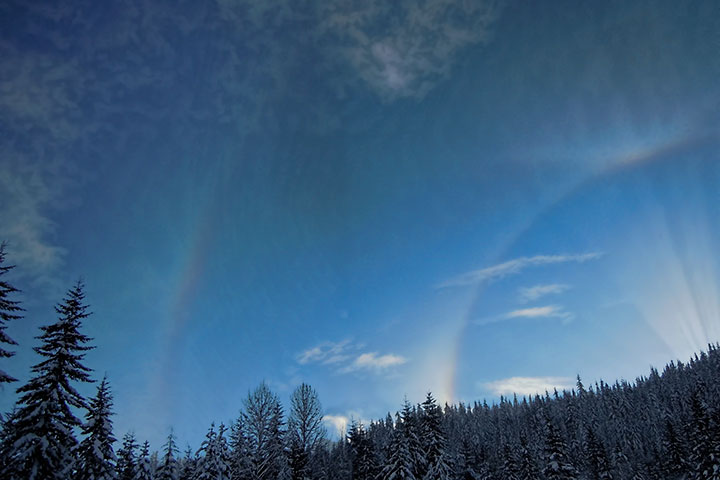I am an enthusiastic sky watcher. By any standard, yestermorn’s sky was magnificent: a medley of haloes embellished with crepuscular rays.
Shifting in brightness, the haloes would come and go. Seen (top to bottom) were: circumzenithal arc (with brilliant colours), supralateral arc (quite faint in the first picture), Parry arc (perceptible but faint), upper tangential arc (in the shape of bird wings and touching the top of the), 22° halo (a circle centred on the Sun). The crepuscular rays appeared inside the 22° halo.
The Sun was 15° above the astronomical horizon but unseen behind the ridge. There would have been parhelia had not the ridge also blocked them from view.
The Christmas Eve halo complex has a key on the right. When this picture was taken the supralateral arc was faint. But, it appears in the second picture, below.

This was taken a short time before the above picture. The supralateral arc is seen sweeping down on the left-hand side. (This arc is easily confused with the 46° halo, something that did not seem to be present).

wonderful, totally sexy pix, i even understand the terminology – nice medley of poetry and scientific jargon – thanks alistair.
what causes these intriguing phenomena? ice cristals in the air?
peter b
Peter, all of the optical features in the pictures (other than the blue of the ski) are a result of sunlight interacting with ice crystals. Mind you, the crepuscular rays can form in other things (fog, haze, smoke), but the rest of the haloes and arcs require crystals. The crystals have simple shapes, either hexagonal plates or columns, and the type of arc formed depends upon the crystal type, dimensions and orientation. You can find explanations at Les Cowley’s site Atmospheric Optics.